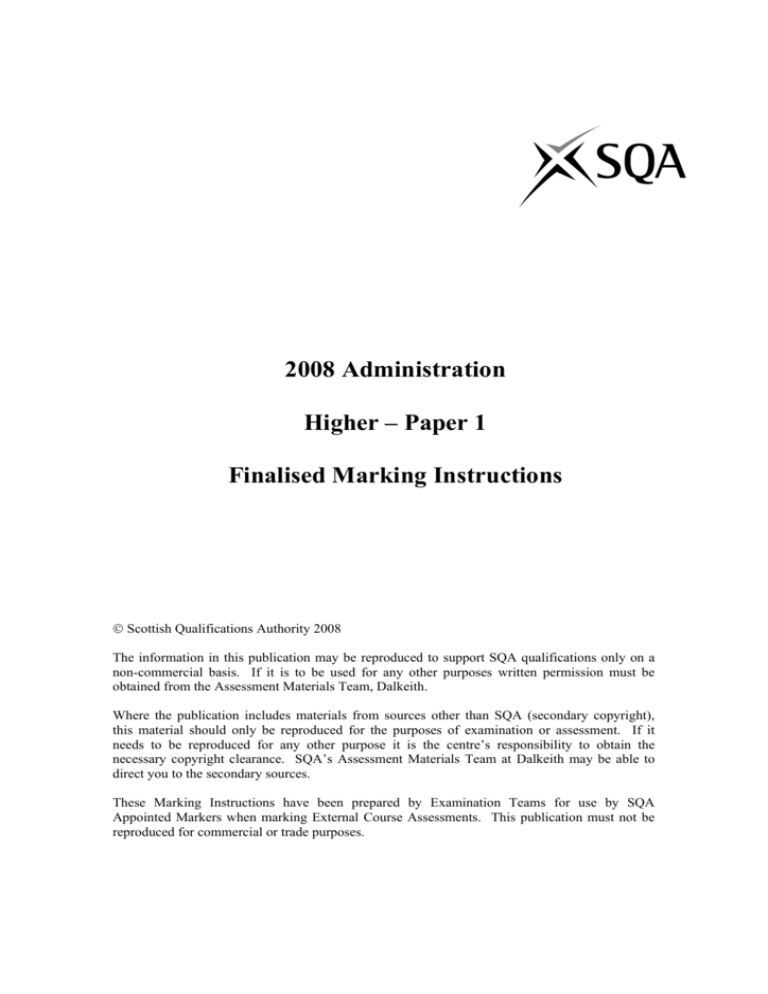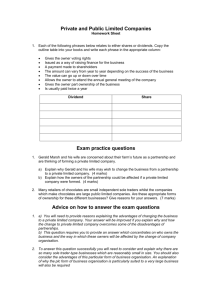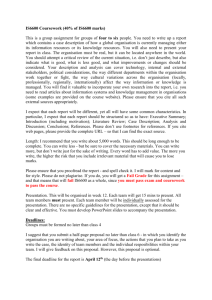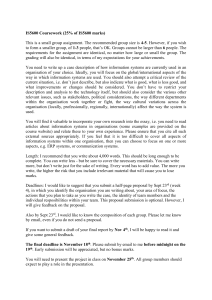2008 Administration Higher – Paper 1 Finalised Marking Instructions
advertisement

2008 Administration Higher – Paper 1 Finalised Marking Instructions © Scottish Qualifications Authority 2008 The information in this publication may be reproduced to support SQA qualifications only on a non-commercial basis. If it is to be used for any other purposes written permission must be obtained from the Assessment Materials Team, Dalkeith. Where the publication includes materials from sources other than SQA (secondary copyright), this material should only be reproduced for the purposes of examination or assessment. If it needs to be reproduced for any other purpose it is the centre’s responsibility to obtain the necessary copyright clearance. SQA’s Assessment Materials Team at Dalkeith may be able to direct you to the secondary sources. These Marking Instructions have been prepared by Examination Teams for use by SQA Appointed Markers when marking External Course Assessments. This publication must not be reproduced for commercial or trade purposes. 2008 Higher Administration Solution and Marking guidelines ANNOTATION Where you award a mark show it like this (You may wish to bracket the relevant scoring point) 1 Put the total for the question in the first column on the right 2 Put the total for the whole question in the second column 18 20 Page 2 SECTION ONE – CASE STUDY 1 In addition to “good people skills, outline 4 leadership skills you would expect to see in an effective leader. 4 More than naming, but not a detailed description. Candidate will not be expected to develop their answers. Good communication skills, could be written or verbal Able to build trust and relationships within the team Able to listen to ideas so that all the team are included Able to influence others towards the achievement of goals Able to ensure conflict is kept to a minimum Able to deploy team skills effectively Having the necessary technical expertise and knowledge required for the job Able to think clearly… Analyse problems and results … Know how to delegate… Able to motivate… Notes: May use cognitive, action, relationship and expert as part of their answer, but a brief outline is still required for these 4 points. Accept written and verbal communication as two separate points but each must be outlined Page 3 2 Describe 3 ways in which the team may be affected by poor leadership 6 Award one mark for outline plus one for additional comment, illustration or example. The team will be unclear on what they have to do and as a result resources may be wasted and the job may not be done properly. Conflict will exist between team members and the job may not get done properly. The group is unlikely to be motivated and they will take longer than anticipated to meet their targets. Morale will be poor and there is likely to be a high staff turnover. Individuals working separately are less effective than a team therefore output will be less. A team with poor leadership will not be properly monitored and therefore likely to do the minimum required/just sufficient to get the job done. They are unlikely to be able to work under pressure and team members will suffer from stress or sustain a standard of work for any length of time. Notes: Development points must be different for each way described to gain each second mark. Accept similar points to question 1 Page 4 3 Discuss the advantages and disadvantages of recruiting internally and externally. 6 If no attempt at discussion then only 50% of the marks available. If no discussion please indicate with “NO D”. Must hit each of the 4 areas to gain the first 4 marks – 2 additional points from any area to gain final 2 marks. Internal • • • • • • It gives employees within the company a chance to develop their career. Shorter induction period needed as the employee is likely to be familiar with the company. Employers will know more about internal candidates’ abilities – this should reduce the risk of employing the “wrong” person. May be quicker and less expensive than recruiting from outside the business. With internal recruitment another vacancy will be created. Smaller pool of applicants. External • • • • • • • Introduces new or fresh ideas/skills. Could produce a bigger pool of applicants. Candidates might be of better quality. Candidates less well known and therefore more risk in employing the wrong person. Could demotivate existing employees. Expensive … Time consuming … Notes: • • • • Accept views of organisation and employees Be aware of awarding an extra mark for simply stating the opposite/flip side of an answer. Second mark can be awarded if there is development. Do not award marks for outsourcing recruitment. Accept 2 separate paras on internal and external as an example of discussion Page 5 4 The job specification and a person specification are used in the recruitment and selection process. Compare these 2 documents. 4 One mark is allocated for each complete statement comparing job description and person specification. Both result from the job analysis. Information from both documents is used to prepare the job advertisement. Both are used by the candidate/organisation in the preparation for the interview. The Job Description clearly defines the duties and responsibilities associated with the job whereas the person specification lists skills and qualities required for the job. The person specification looks at essential and desirable qualities whereas the job description simply lists the duties or tasks. Notes Page 6 SECTION 2 1 (a) Outline 4 flexible working practices which may exist in an organisation. 4 More than naming, but not a detailed description. Candidate will not be expected to develop their answers. Flexible working practices cover many different variations of work, workers and the workplace. Flexibility of work Part-time – one person working less hours than a full time post Job-share – 2 or more people sharing one full time position Flexi-time – where start and finish time can vary to suit individual needs. Employee must be in the office during core time. Homeworking/Teleworking – where the employee can work (with the aid of IT) at home at a time which suits their personal circumstances Flexibility of workers Temporary … Part-time contracts … Fixed term contracts … Career break … Flexibility of the workplace Hot desking … Touchdown area … Videoconferencing … Notes: • • Accept unpaid leave/leave of absence Accept Outsourcing Page 7 1 (b) Discuss the impact of flexible working practices on the modern working environment. If no attempt at discussion then only 50% of the marks available. If no discussion “NO D”. On Organisation/Individual Employers can recruit and retain valued staff1 and meet changing customer requirements more easily1. However there may be a lack of continuity and therefore customers would be dissatisfied1. The individual can balance work with other commitments. Costs can be cut by using peripheral workers eg fixed term contracts to cover busy periods. Introduction of hot-desking means that savings in office space can be made. Co-ordination of work flow, training etc is more difficult for management. … Results in increased productivity … Improved morale … Reduction of stress (less time taken off work) Notes Both positive and negative accepted Page 8 8 1 (c) Describe ways in which an organisation can prevent computer viruses. 6 Award one mark for outline plus one for additional comment, illustration or example. Three ways must be described to gain full marks. Install high quality antivirus software on all computers and ensure that antivirus software is updated regularly. Firewalls can be installed to prevent outside sources accessing system/data. This is important to organisations which run web-sites. Forbid employees from using disks which have been used on computer systems outwith the organisation unless checked on a standalone PC. Install software which filters “spam” e-mails. The user can then releases/mark as safe/ deletes the email as required. Inform and advise staff on organisational procedures eg organise training, hands-on demonstrations, prevention of downloading software etc. Notes: • • • Do not accept measures once virus is in the system. Must be preventative. Accept “passwords” if clarified regarding prevention of hacking. Development points must be different for each way described to gain each second mark. Page 9 1 (d) Justify the expense of installing electronic safeguards in a computer system. 2 One mark for each valid point justified. To prevent unauthorised access to confidential information. To prevent virus/corruption of data. Greater customer confidence that their data is safe. Organisation can be more confident that data is more reliable – enables better decision making. Loss of data could be time consuming and/or costly to replace. Less open to fraud and consequent legal implications. Flow of work not disrupted. Notes: Page 10 2 (a) Describe 3 consequences and their implications to an organisation of inadequate preparation for meetings. 6 Award one mark for stating the initial consequence plus one for subsequent implication. Consequence and implication must be linked. Paperwork not available – reputation of secretary and chairperson might suffer. The venue might be double booked – the meeting may need to be postponed/attendees may be greatly inconvenienced. A poor agenda – may result in the meeting over-running. Travel issues (parking, directions, proximity to public transport) – start of meeting might be delayed, quorum not met … Non-receipt of papers in advance of a meeting – may result in insufficient or illinformed discussion/decisions. Suitable equipment not available – speakers/presentations delayed and staff frustrated. If you have not followed procedures – you may invalidate any decisions made. Notes: • • Do not accept consequences relating to the running of the meeting. If consequence is inaccurate, no mark for the implication relating to it. Page 11 2 (b) An Administrative Assistant will use a variety of software when planning a meeting. Discuss the use of at least 3 software packages for this purpose. 8 If no attempt at discussion then only 50% of the marks available. If no discussion “NO D”. Three software packages must be discussed for full marks to be gained. Two marks are available per software with 2 additional marks for other software or further points. Word Processing Preparing Notice of Meeting/Agenda Preparing Previous Minutes Mail merge letters to those attending Label wizard. Spreadsheet Used to prepare costings for meeting eg travel, accommodation, venue etc. Database Mail Merge Searching for information about attendees Holding information about possible venues etc. Email and Electronic Diary Sending emails with appropriate attachments (Notice of Meeting etc) Ediary – checking people’s ediary for availability to attend meeting. To-do/Task lists to organise tasks regarding the meeting. Internet Researching information needed at the meeting Finding venue availability Finding accommodation for people attending the meeting. Notes: Only accept powerpoint if tied to the planning of the meeting. Page 12 2 (c) Justify why some teams use Action Minutes. 2 One mark for each valid point justified. Lists the action agreed – easier to keep track of just what has actually been carried out. Easy to identify who is responsible for carrying out the task. The target date by which the task is to be completed is identified. Quicker to produce as they only detail key points. Notes: • • Do not award marks for simply stating the purpose of minutes Do not award marks for “quick” and “easy” Page 13 2 (d) Outline the benefits of dealing with customers face to face. 4 More than naming, but not a detailed description. Candidate will not be expected to develop their answer. Allows for interaction between interviewer and interviewee. Allows for more subtle questioning. The customer feels more valued/listened to. More likely that relationships will be formed between customer and organisation. Clarification can be gained in a face to face, verbal communication. Demonstrations can be given if required. They can be useful for expanding basic statistical information. May be more appropriate if the discussion is confidential. Allows you to read the body language. Promotes a good reputation that would ensure customer loyalty. Notes: Page 14 3 (a) Outline the factors which will determine whether an organisation will train customer service employees in-house or externally. 4 More than naming, but not a detailed description. Candidate will not be expected to develop their answers. Cost/Budget – Internal is more cost-effective than external training (travel, accommodation etc not required). Time - Internal can be arranged as and when necessary. Facilities available – What equipment is available within the organisation? Suitable Learning Environment – Staff can be easily distracted and interrupted if they are in their own workplace. Staff are not as easily distracted by interruptions in a different environment. Need for formal qualification – external more likely to provide this. Existing skills within the workplace – In-house trainers may lack credibility. Number of people to be trained … Other factors: It can be more easily tailored to meet individuals’ and organisation needs. Staff may feel more comfortable in familiar surroundings. Can staff cascade new knowledge and skills to other staff on return to the workplace? External training staff have the ability to network with others and exchange views and ideas. The organisation has little control over the length and content of the course. Notes Page 15 3 (b) Justify the provision of a staff counselling service within an organisation. One mark for each valid point justified. Expert advice can be given on a whole range of job issues. Career development advice can be given. Advice on changing personal circumstances. Unbiased advice will be available. Staff will feel supported. Staff will know that information will be treated confidentially. Increased staff morale. Lower absenteeism. Lower staff turnover. Notes: Page 16 2 3 (c) Discuss good practice an organisation would adopt to ensure complaints are handled effectively. 8 If no attempt at discussion then only 50% of the marks available. If no discussion “NO D”. Have an established complaints procedure. The complaints procedure is transparent and available to all customers and is known to all staff. Any complaints received are logged. Those who handle complaints are given careful training eg time in which to reply and method of reply … It is often effective to have the same person deal with the complaint from start to finish. The process of investigation is tracked internally. All complaints received are acknowledged immediately, usually in writing, along with details outlining the process the investigation will take. All complaints are given a high priority. Clear timelines should be established to ensure prompt investigation and any deviation from the given timelines should be communicated to the customer. The result of the investigation is communicated to the customer and, if appropriate, compensation of some kind may be offered. All complaints are reviewed on a regular basis to identify any patterns or issues which the organisation should address. Notes: • • Development points more likely if discussion has taken place. No marks for stating how complaints are received. Page 17 3 (d) Describe ways in which a Senior Administrative Assistant would ensure that time is managed effectively. 6 Award one mark for outline plus one for additional comment, illustration or example. Three ways must be described for full marks to be gained. To do list: giving each job a priority – trying to note how long you will spend on a job and try to stick to your list. Try to prioritise your tasks: urgent and non-urgent, high, medium and low priority. Most tasks fall into one of three categories, immediate action by you, some action by you but also some on-going work by you or others and information for reading, circulating, filing or disposing of. Try to handle papers or tasks only once – read them, take the actions needed, and file them. At the end of each day try to clear your desk … Make sure you do the most difficult tasks in your prime time when you are at your best … Do not put off difficult tasks … Make use of delegation … Avoid interruptions/telephone call management technique … Make use of planning aids … Notes: Accept the time management of a junior. Page 18 4 (a) Describe 2 long-term implications to the organisation of using poor quality information. 4 Award one mark for outline plus one for additional comment, illustration or example. … Loss of customers … … Decreased productivity … … High staff turnover … … Bad publicity – loss/bad reputation … … Potential legal action taken against the organisation … Notes: • • • First outline mark can be awarded for a consequence. Watch for repetition of consequences eg poor decision making. Related implications can be awarded second mark. Page 19 4 (b) Describe 3 types of information used by an organisation when making decisions. 6 Award one mark for outline plus one for additional comment, illustration or example. Qualitative information … Quantitative information … Written information … Oral information … Numerical information … Graphical information … Notes: • • Do not award marks if simply stated as above. Accept Primary, Secondary, Internal and External as types of information. Page 20 4 (c) Establishing good practice in electronic file management is important to all organisations. Discuss the benefits of this and the consequences of poor file management. 8 If no attempt at discussion then only 50% of the marks available. If no discussion “NO D”. Both benefits and consequences must be discussed for full marks. Must be at least one mention of either benefit or consequence. Benefits • • • • • Improved information handling. Better security of data. Efficient use of file memory. No time wasted finding files. Obvious pathways for all staff to follow. Consequences • • • • • • • • • • • • Work not completed on time. Out-of-date information being accessed. Information not found. Confidential information may be left in files which can be assessed by all. If housekeeping tasks of tidying and deleting files are not followed regularly, more time will be wasted and system will slow down. Lack of customer satisfaction. Cost the organisation money as time is wasted. There may be legal consequences if data is mishandled. Increased stress/frustration for staff. Decreased motivation of staff. Low productivity. Inefficiency. Notes: Page 21 4 (d) Outline 2 offences under the Computer Misuse Act 1990. 2 More than naming, but not a detailed description. Candidate will not be expected to develop their answers. Unauthorised access of computer material. Unauthorised access with the intent to commit or help further offences. Unauthorised changes to contents of any computer. Notes: Page 22 5 (a) i Outline 2 features of a Personal Development Plan. 2 More than naming, but not a detailed description. Candidate will not be expected to develop their answers. Identifies areas of strength and weakness. Identifies training needs. Setting targets for the member of staff to work to. It looks at the development of the individual employee. It is all about the aspirations of the employee. It looks at broad long-term development. Development does not have to be related to work tasks. Should be written in a structured way. Notes: Page 23 5 (a) ii Describe 2 methods of monitoring the progress of an employee’s Personal Development Plan. 4 Award one mark for outline plus one for additional comment, illustration or example. No marks for naming the method. Buddy system. This is where an employee is paired with a more experienced person, usually at the same level, who can be called upon for help and advice. This will usually be someone who is familiar with all the details of the job and the organisation. Mentoring system. Here a more senior member of staff is assigned to an employee. This senior member of staff can be relied upon to supply help and advice as well as knowledge of the organisation and how it works. Line manager. This might involve the line manager doing periodic checks of work or discussions about progress of tasks to ensure that organisational policy is being adhered to and the required quality standards are being met. Internal audits. Many organisations use some type of quality system to check that organisational standards and quality standards are being met. These internal audits are usually carried out by someone external to the department but internal to the organisation. Appraisal ... Notes: Page 24 5 (b) Suggest a way in which each of the following spreadsheet features may be used: • Comments • Conditional formatting • Dynamic linkage • Named range. 4 Award one mark per suggestion. Comments: are a useful way of adding your thoughts on the content of the cell. Also a good way of tracking changes. They are like electronic sticky notes/reminder. Conditional formatting: is a way to automatically distinguish between data within a range of cells eg if the condition is met then data will appear as a particular colour. Allows quick analysis of data within the spreadsheet. Dynamic linkage: used to link a spreadsheet and a word document whereby if you change the spreadsheet, the change will automatically update in the word document. Named Range: to give a name to a range of cells which can then be used in your formula instead of clicking over large numbers of cells. Can make it easier to see how a formula is constructed. Absolute referencing is not required. Makes working with a large volume of data more easy. Notes: • Accept examples of occasions when the spreadsheet features may be used. Page 25 5 (c) Discuss how office layout can affect productivity. 6 If no attempt at discussion then only 50% of the marks available. If no discussion “NO D”. Accept discussion on the following areas: Open Plan, Cellular, Ergonomics Eg If the area is unsafe or insecure this can effect staff morale Noise … Distraction … produce stress Having enough physical space so that you do your work efficiently Lack of storage space Lack of privacy can demotivate Notes: • Accept an inference that productivity is either increased or decreased. Page 26 5 (d) Justify the expense to an organisation of introducing an intranet. 4 One mark for each valid point justified. Enhances internal communication within an organisation. Increase in employees’ productivity due to the increase in the volume of information which can be accessed, processed and transmitted. Increase in the speed and ease with which information can be accessed, processed and transmitted. Improvement in the quality of output of information (accuracy and appearance). Increased opportunities to standardise the collection, processing and transmission of information within the organisation. Cost savings due to email facility. Improved competitive edge because of improved working practices. Staff can access information from wherever they connect to the Intranet. Allows the organisation to quality control the information. Allows the organisation to keep information up to date Company proformas/policies and procedures can be stored for all staff to access. Pool ideas via a noticeboard. Notes: [END OF MARKING INSTRUCTIONS] Page 27









